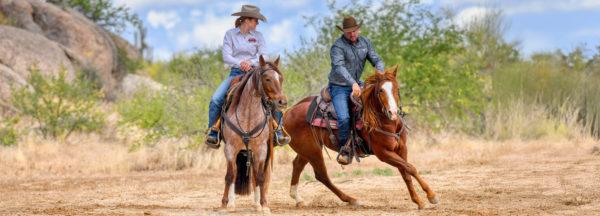Buddy-Sour Horses on the Trail


March No Worries Club Preview: Buddy-Sour Horses on the Trail
Horses love the familiar even more than we do, so getting separated from friends is a legitimate cause for upset. However, it’s also a sign that they’re using the reactive side of their brain, not the thinking side. When you’re riding, and your horse gets anxious about being separated from the group or split up from a particular horse, he’s not thinking; he’s reacting. It means he’s unpredictable and fearful, and the situation can turn dangerous. He’s tuned into his prey-like animal tendencies and gives little thought to anything else, including his or your safety.
By being a leader and building your horse’s confidence, you can get him to focus on you and alleviate his anxiety about being separated from his buddies. That’s why Clinton Anderson from Downunder Horsemanship has developed a way to train horses, regardless of their past problems or traumas. It begins with training the owners to gain their horse’s respect and understand how to control them properly. Join Clinton on his weekly endeavors of tackling some of the most challenging situations with problem horses and problem owners. This week, we hear about another valuable lesson from Clinton’s No Worries Club—how to handle buddy-sour horses on the trail.
Clinton starts the episode by introducing us to the horses he’s working with out in the desert. He mentions that horses naturally want to bunch up or group up—they don’t want to leave and go out on their own paths. Unfortunately, this isn’t ideal for horsemen and can be dangerous for the riders. Fortunately, there’s a way to fix it.
Buddy-sour behavior is a common occurrence. It’s worse when horses have been living in the same pasture or when they’re stalled together, go in the trailer together, and spend most of their time together. The best way to “divorce” two horses is to alternate between keeping them together when they’re working and dividing them up when they’re resting. Horses are motivated by rest, so if they know that resting happens when they’re not together, they’ll look for that moment.
Typically, with buddy-sour horses, people try to force them to separate. Clinton tells us that we’re not going to do that. We’re going to do the opposite. You want to let them get next to each other. Then, you’ll put them to work. Start by trotting around in a tight little circle. You want the horses to chase each other like a dog chasing its tail—the tighter the circle and the more you make the horses hustle, the better. Then, after a few circles, change directions. Turn both horses out and go in the other direction. The key is giving the horses lots of direction changes within a tight space, making being next to each other hard work.
After a few minutes of working the horses next to each other, ride them away from one another. Then let them stop and relax and get their air. Let the horses rest for several minutes and then go back to working them next to each other.
The lesson is that the more you try telling buddy-sour horses to leave each other, the more they want to stay together. The more you make them stay together in challenging situations, the more they want to separate. That’s the trick! Everybody keeps trying to make them get apart, but you need to do the opposite and make them get together. As soon as they try to get close to each other again, just repeat the process and start circling the other horse immediately. Throughout the exercise, you can see that the horses naturally keep getting farther and farther apart. They’re less keen to stand close together because they’re starting to associate each other with more work. And that’s how it’s done!
To learn more about the Downunder Horsemanship training method, become a member of the No Worries Club, or get information on any of the products seen on our show, head over to our homepage and download the Downunder Horsemanship app today!

